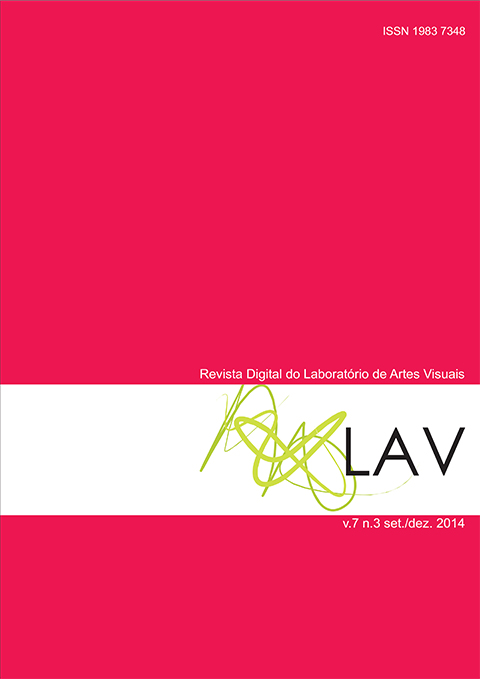Of borders, bodies and liminal spaces
DOI:
https://doi.org/10.5902/1983734816718Keywords:
Performance, Performativity, Border, Gender and embodimentAbstract
This article addresses the increasing interest of the border as a research topic in art, understood as fiction, material and discursive construction, space of cultural, racial, economical and corporeal regulation… Through video graphic artistic projects like Performing the Border or Maquilapolis, we analyze dilemmas and visual and conceptual strategies that emerge in politics of re-presentation and documentality. To analyze the case of maquiladoras settled on the border between Mexico and EUA, it will be clue to tackle in a complex way concepts such as ‘performance’ and ‘performativity’ from Performance Studies, that contribute an analysis about the relation among neoliberal economy, work, body, gender, sexuality, capital and technology. On the other hand, feminist approaches highlight the relevance of politics of enunciation, representation and visibility, as well as practices of embodiment by concepts like ‘cyborg’, ‘excentric identities’, ‘technologies of gender’, etc.Downloads
References
Anzaldúa Gloria (1999), Borderlands. La Frontera. The New Mestiza. San Francisco: Aunt Lute Books.
Anzaldúa Gloria y Cherríe Moraga (Ed.) (1983 [1981]) This Bridge Called my Back. Writings by Radical Women of Color. New York: Kitchen Table Women of Color Press.
Bhabha Homi (1994) The Location of Culture. London and New York: Routledge.
Biemann Ursula (2001) Making the Transnational Intelligible: performing the border, en Sadowsky Claudia (Ed.) (2001) Globalization on the Line: Gender, Nation, and Capital at U.S. Borders. St. Martin's Press. Descargable también en la web http://www.geobodies.org/03_books_and_texts/2008_mission_reports/ [consultado
el 26 de Abril del 2010].
Braidotti Rosi (2000 [1994]) Sujetos nómades, corporización y diferencia sexual en la teoría feminista contemporánea. Barcelona: Paidós.
Burr Vivian (1997) Introducció al construccionisme social. Barcelona: Proa.
Cheng Meiling (2002) In Other Los Angeleses: Multicentric Performance Art. Los Angeles: University of California Press.
Crary Jonathan (2008 [1992]) Técnicas del observador. Visión y modernidad en el siglo XIX. Murcia: CENDEAC.
Debord Guy (2002 [1967]) La sociedad del espectáculo. Valencia: Pre-textos.
De Lauretis Teresa (2000a) “Sujetos excéntricos” en Diferencias. Madrid: Horas y Horas.
_______________(2000b) “Tecnologías del género”. En Diferencias. Etapas de un camino a través del feminismo. Madrid: Horas y Horas, cuadernos inacabados, 35.
Deleuze Gilles y Guattari Félix (2004 [1980]) Mil mesetas. Capitalismo y Esquizofrenia. Valencia: Pre-textos.
Guattari Félix; Suely Rolnik (2006) Micropolítica. Cartografías del deseo. Madrid: Traficantes de Sueños.
Hall Stuart (2006 [1990]) “Cultural Identity and Diaspora”, en Evans Jana y Mannur Anita (Eds.) (2006) Theorizing Diaspora. Malden: Blackwell.
Haraway Donna (1991a [1985]) “Manifiesto para cyborgs: ciencia, tecnología y feminismo socialista a finales del siglo XX” en, Ciencia, cyborgs y mujeres. La reinvención de la naturaleza. Madrid: Cátedra.
_____________(1991b [1988]) “Situated Knowledges. The Science Question in Feminism as a Site of Discourse on the Privilege of Partial Perspective”, en Haraway Donna Simians, Cyborgs, and Women : The Reinvention of Nature. London and New York: Routledge.
Jay Martin (2003) Campos de Fuerza: entre la Historia Intelectual y la Crítica Cultural.
Buenos Aires: Paidós.
McKenzie Jon (2004) “The Liminal-Norm” en Bial Henry (ed.) (2004) The Performance Studies Reader. London and New York: Routledge.
___________(2001) Perform or Else. From Discipline to Performance. London and New York: Routledge.
Michaelsen, Scout y Johnson, David E. (Eds.) (2003) Teoría de la Frontera: Los Límites de la Política Cultural. Barcelona: Editorial Gedisa, S.A.
Sandoval; Mohanty; Brah y otras (2004) Otras inapropiables. Feminismos desde las fronteras. Madrid: Traficantes de sueños.
Sassen Saskia (2003) Contrageografías de la Globalización: Género y ciudadanía en los circuitos transfronterizos. Madrid: Traficantes de Sueños.
Seltzer Mark (1998) Serial Killers: Death and Life in America’s Wound Culture. London and New York: Routledge.
___________(1992) Bodies and Machines. London and New York: Routledge.
Steyerl Hito (2004) “La política de la verdad. Documentalismo en el ámbito artístico”. En Ficcions documentals. Barcelona: Caixaforum.
Turner Victor (1980) “Social Dramas and stories about them”, en Auslander Philip (Ed.) (2003) Performance. Critical Concepts in Literary and Cultural Studies. Vol. III. London and New York: Routledge.
___________(1969) The Ritual Process. Middlesex: Penguin Books. Williams Linda (2004) (Ed.) Porn Studies. Durham and London: Duke University Press
Woodward Kathleen (Ed.) (1997) Identity and difference. London, Sage.
Wright Melissa (2000) “Maquiladora Mestizas and a Feminist Border Politics: Revisiting Anzaldúa”, en Narayan Uma y Harding Sandra (ed.) (2000) Decentering the Center.
Philosophy for a Multicultural, Postcolonial, and Feminist World. Bloomington: Indiana University Press.
Yúdice George y Miller Toby (2004) Política Cultural. Barcelona: Gedisa.
Yúdice George (2003) El recurso de la cultura. Usos de la cultura en la era global. Barcelona: Gedisa.






